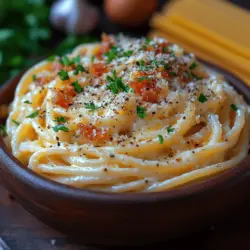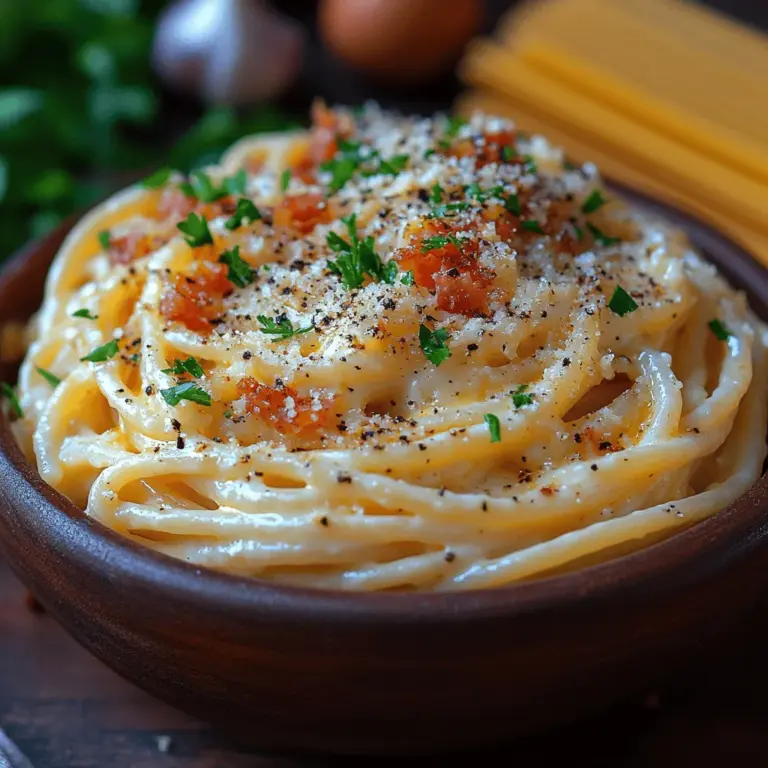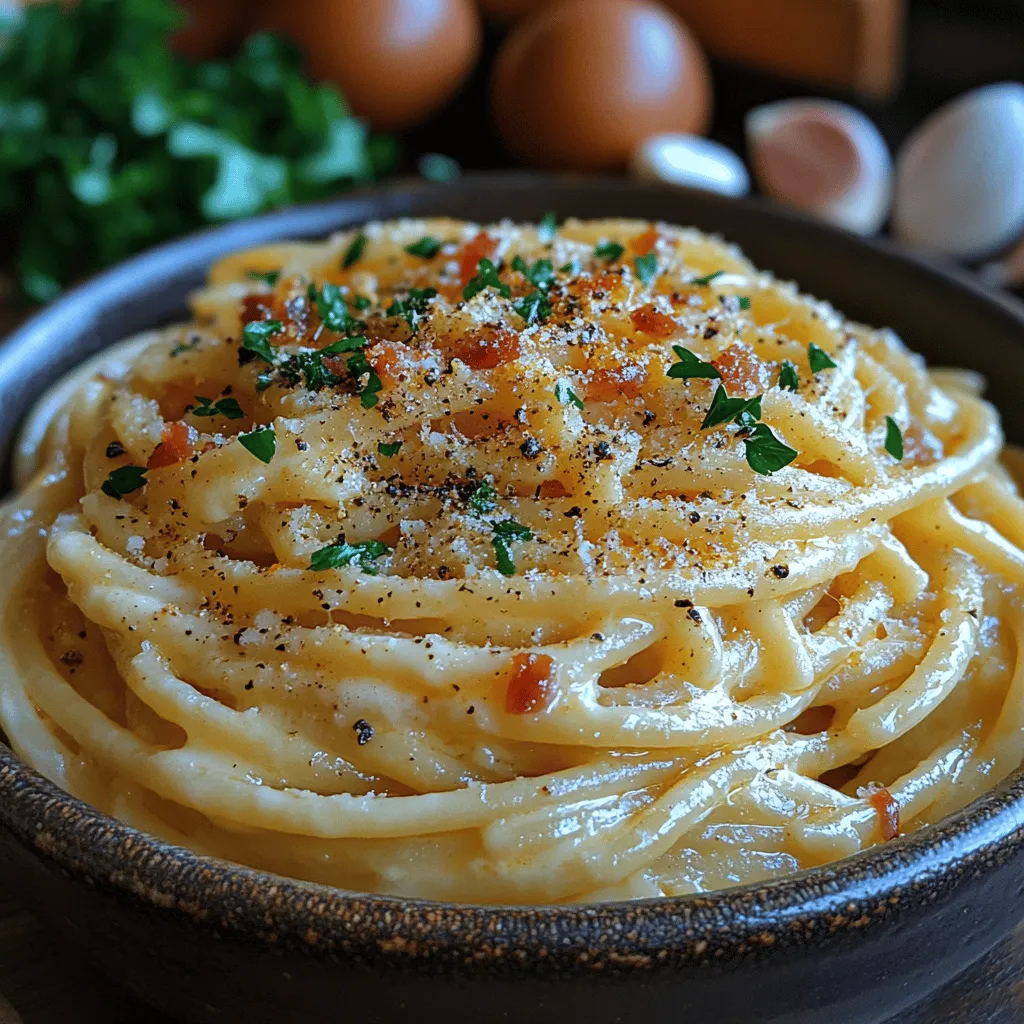Introduction to Spaghetti Carbonara Deliziosa
Welcome to the rich and creamy world of Italian cuisine! Today, we will explore the mouthwatering Spaghetti Carbonara Deliziosa, a dish that embodies the essence of Italian cooking with its simplicity, bold flavors, and comforting textures. Spaghetti Carbonara is not just a meal; it’s an experience that transports you to the charming streets of Rome with every bite.
This classic dish features al dente spaghetti tossed with crispy pancetta and enveloped in a luxuriously rich sauce made from eggs and cheese. What makes Carbonara so special is its ability to deliver complex flavors while using just a handful of high-quality ingredients. In this article, we will guide you through every step of creating this iconic dish, providing you with insights into its origins, variations, and perfect pairing options. Whether you are a seasoned chef or a novice in the kitchen, you will find that mastering Spaghetti Carbonara is not only achievable but also immensely satisfying.
Understanding the Origins of Carbonara
To truly appreciate Spaghetti Carbonara, it’s essential to delve into its history. This beloved dish traces its roots back to the Lazio region of Italy, specifically to the capital city, Rome. While the exact origins remain a topic of culinary debate, many believe that Carbonara was created in the mid-20th century, shortly after World War II.
The name “Carbonara” is thought to derive from “carbonaro,” meaning “coal worker” in Italian. Some historians suggest that the dish was a favorite among Italian charcoal workers who would prepare it over an open flame. Others speculate that it was named after the black pepper that resembles coal dust when sprinkled over the dish. Regardless of its origins, Carbonara has evolved into a staple of Italian cuisine, celebrated for its rich flavors and creamy texture.
Traditionally, Carbonara is made with a few key ingredients: pasta, eggs, cheese, and cured pork. Over the years, many variations have emerged, with chefs adding their own twists and regional adaptations. However, the essence of Carbonara remains the same – a simple yet indulgent dish that showcases the beauty of Italian cooking.
Key Ingredients for Spaghetti Carbonara Deliziosa
Spaghetti: The Perfect Base
At the heart of every Carbonara is spaghetti, a long, thin pasta that serves as the perfect base for the dish. The importance of choosing the right pasta cannot be overstated. Authentic Italian Carbonara typically uses spaghetti, but other long pasta varieties like fettuccine or bucatini can also work well.
When selecting spaghetti, look for high-quality durum wheat pasta, which offers the ideal texture to hold the creamy sauce. Cooking it to al dente is crucial, as it allows the pasta to absorb the flavors of the sauce while maintaining a firm bite. Remember, the goal is to create a harmonious blend of pasta and sauce that delivers a delightful experience in every forkful.
Pancetta: The Flavorful Star
Pancetta is the unsung hero of Spaghetti Carbonara, providing a savory depth that elevates the dish to new heights. This Italian cured meat, made from pork belly, is typically seasoned with spices and herbs before being rolled and aged. Its rich, fatty flavor and crispy texture when cooked make it an essential ingredient in Carbonara.
When selecting pancetta, opt for high-quality, artisanal brands to ensure the best flavor. You can find it at specialty grocery stores or Italian delis. If pancetta isn’t available, guanciale (cured pork cheek) is the traditional choice used in authentic Roman Carbonara. However, if you prefer a more accessible option, pancetta will still yield delicious results.
Eggs: The Creamy Binder
The magic of Carbonara lies in its sauce, which is primarily made from fresh eggs. The eggs act as a creamy binder, creating a luxurious sauce that coats each strand of spaghetti. For the best results, use high-quality, fresh eggs, preferably free-range or organic.
When the hot pasta is combined with the beaten eggs, the residual heat gently cooks the eggs, transforming them into a silky sauce without scrambling them. This technique is key to achieving the perfect Carbonara consistency. Keep the eggs at room temperature before use to ensure they blend seamlessly with the pasta.
Cheeses: Pecorino Romano and Parmigiano-Reggiano
To achieve the authentic flavor of Spaghetti Carbonara, two cheeses are paramount: Pecorino Romano and Parmigiano-Reggiano.
Pecorino Romano is a hard, salty cheese made from sheep’s milk, known for its strong flavor and crumbly texture. It is a staple in Roman cuisine and provides a distinctive taste that balances the richness of the eggs and pancetta.
Parmigiano-Reggiano, often referred to as the “King of Cheeses,” adds a nutty and savory note to the dish. Grating both cheeses fresh will ensure the best flavor and texture in your Carbonara. A mix of these two cheeses will give your dish depth and complexity, making every bite an exquisite experience.
Garlic and Black Pepper: The Flavor Enhancers
While traditional Carbonara recipes may not always include garlic, a hint of it can enhance the dish’s flavor profile. A light sauté of minced garlic in the pancetta drippings can add an aromatic touch without overpowering the other ingredients.
Additionally, freshly cracked black pepper is a crucial component of Carbonara. It adds a subtle heat and depth that balances the creamy sauce and salty pancetta. The key is to use freshly cracked pepper for the best flavor. A generous sprinkling on top of the finished dish will elevate your Carbonara to gourmet status.
Garnishing with Fresh Parsley
Although garnishing may seem like an optional step, a sprinkle of freshly chopped parsley adds a pop of color and brightness to your Spaghetti Carbonara. The vibrant green of the parsley contrasts beautifully with the creamy sauce and rich pancetta, making the dish more visually appealing. Moreover, parsley offers a fresh herbal note that enhances the overall flavor.
Step-by-Step Guide to Preparing Spaghetti Carbonara Deliziosa
Now that you have a solid understanding of the key ingredients, it’s time to dive into the step-by-step process of preparing Spaghetti Carbonara Deliziosa. Follow these instructions carefully to ensure a perfect outcome:
1. Gather Your Ingredients: Start by gathering all the necessary ingredients. You’ll need spaghetti, pancetta, eggs, Pecorino Romano cheese, Parmigiano-Reggiano cheese, garlic (optional), black pepper, and fresh parsley for garnish.
2. Cook the Pasta: Bring a large pot of salted water to a boil. Add the spaghetti and cook according to the package instructions until al dente. Reserve about a cup of the pasta water before draining, as it will be used to adjust the sauce’s consistency later.
3. Prepare the Pancetta: While the pasta cooks, heat a large skillet over medium heat. Add the diced pancetta and cook until it becomes crispy and golden brown, about 5-7 minutes. If you’re using garlic, add minced garlic to the pan during the last minute of cooking, allowing it to soften slightly without burning.
4. Beat the Eggs and Cheese: In a mixing bowl, whisk together the eggs, grated Pecorino Romano, and Parmigiano-Reggiano until well combined. Season with freshly cracked black pepper to taste. The mixture should be smooth and creamy.
5. Combine Pasta and Pancetta: Once the spaghetti is cooked and drained, add it to the skillet with the crispy pancetta. Toss the pasta in the pancetta drippings to coat the strands evenly. Remove the skillet from heat to prevent the eggs from scrambling in the next step.
6. Create the Sauce: Quickly pour the egg and cheese mixture over the hot pasta, tossing continuously to coat the spaghetti evenly. The heat from the pasta will gently cook the eggs, creating a creamy sauce. If the sauce is too thick, add a bit of the reserved pasta water until you reach your desired consistency.
7. Final Touches: Taste the Carbonara and adjust the seasoning with more black pepper if needed. Serve immediately, garnished with additional grated cheese and freshly chopped parsley for a pop of color.
With these steps, you’ll have a delightful Spaghetti Carbonara Deliziosa that captures the essence of Italian cooking. In the following sections, we will explore tips for perfecting your Carbonara, common questions surrounding the dish, and some delicious pairing options to complement your meal. Stay tuned for more culinary insights that will elevate your cooking experience!
Cooking the Spaghetti
To achieve the perfect Spaghetti Carbonara, the first step is to cook the spaghetti to an al dente texture. Begin by filling a large pot with water, using approximately four to six quarts for every pound of pasta. This will ensure that the spaghetti has enough space to move while cooking, preventing it from clumping together. Add a generous amount of salt to the water—about one to two tablespoons—before bringing it to a rolling boil. The salt not only flavors the pasta but also helps to enhance the overall dish.
Once the water is boiling, add the spaghetti. Stir it gently to prevent it from sticking. Cooking times can vary based on the brand of spaghetti, so it’s essential to check the package instructions for the recommended cooking time. Aim for a cooking time that is one to two minutes less than the package directions to achieve that ideal al dente texture. This means the pasta should be cooked but still have a slight bite when you taste it.
As the spaghetti cooks, it’s crucial to reserve some of the pasta water before draining it. This starchy water is a key ingredient in achieving the creamy texture of the sauce later on. Set aside about a cup of the pasta water, then drain the spaghetti in a colander. Do not rinse the pasta; this will wash away the starch that helps the sauce adhere.
Preparing the Pancetta
Next, we turn our attention to the star of the dish—pancetta. This Italian cured meat is essential for imparting rich, savory flavors to your Carbonara. Begin by cutting the pancetta into small cubes, roughly ½-inch in size. This allows for even cooking and ensures that every bite is infused with its delicious flavor.
In a large skillet over medium heat, add the pancetta. As it starts to cook, you’ll want to keep an eye on the temperature; too high, and the meat will burn before it crisps up. Stirring occasionally, cook the pancetta until it is golden brown and crispy, which usually takes about 5-7 minutes. The fat will render out during cooking, providing a flavorful base for the sauce. Once the pancetta is cooked to perfection, remove the skillet from the heat and set it aside, allowing the fat to remain in the pan.
Making the Egg Mixture
While the pancetta is cooking, you can prepare the egg mixture that will create the creamy sauce. In a mixing bowl, combine three large eggs with about one cup of grated Pecorino Romano cheese. This combination of eggs and cheese is what gives Carbonara its signature creaminess without the use of cream.
Using a whisk, mix the eggs and cheese vigorously until smooth and well combined. The goal is to create a thick, velvety mixture that will coat the spaghetti perfectly. For added flavor, you can include freshly cracked black pepper—about one teaspoon should suffice. This will enhance the dish’s depth and add a bit of spice. Ensure that your mixture is thoroughly blended and set it aside for the next step.
Combining Ingredients
Now comes the moment of truth—combining all the elements into a cohesive dish. Begin by returning the skillet with the pancetta to low heat. It’s essential to combine the spaghetti with the pancetta while both are still warm to ensure the egg mixture cooks slightly, forming a creamy sauce rather than scrambled eggs.
Add the drained spaghetti to the skillet, tossing it gently to coat the pasta in the rendered fat. This step is crucial, as it ensures that every strand of spaghetti is infused with the savory flavor of the pancetta. After the spaghetti is well coated, remove the skillet from the heat.
With the pasta still warm, quickly pour the egg and cheese mixture over the spaghetti, tossing continuously. The residual heat from the pasta will gently cook the eggs, creating a luscious sauce. If the sauce seems too thick, you can gradually add the reserved pasta water, one tablespoon at a time, until you reach your desired consistency. The sauce should be creamy, clinging to the pasta without being runny.
Finishing Touches
Once you’ve achieved that perfect creamy texture, it’s time for the finishing touches. Taste your Carbonara and adjust the seasoning with additional salt and black pepper as needed. If you prefer a hint of garlic, now is the time to add it. For a subtle garlic flavor, you can sauté a minced clove in the pancetta fat before adding the spaghetti; this will infuse the dish without overwhelming the classic flavors.
Serve the Carbonara immediately, garnishing with extra grated Pecorino Romano cheese and a sprinkle of black pepper on top. This dish is best enjoyed fresh, as the creamy sauce can thicken and lose its silkiness if left to sit.
Serving Suggestions for Spaghetti Carbonara Deliziosa
Ideal Wine Pairings
To elevate your dining experience, choosing the right wine can make all the difference. A crisp white wine is the perfect companion for Spaghetti Carbonara, complementing its rich flavors without overpowering them. Consider a Pinot Grigio or a light-bodied Chardonnay, both of which offer refreshing acidity that balances the creaminess of the dish. For a unique twist, a Vermentino can add a delightful herbal note that pairs beautifully with the salty pancetta and nutty cheese.
Side Dishes for a Complete Meal
To create a well-rounded meal alongside your Carbonara, consider serving a crisp salad. A simple arugula salad with lemon vinaigrette can provide a bright contrast to the richness of the pasta. Alternatively, a mixed greens salad with cherry tomatoes and a light balsamic dressing adds freshness. Roasted vegetables, such as asparagus or Brussels sprouts, can also complement the meal well, providing a delightful crunch and a burst of color on your plate.
Nutritional Information and Dietary Considerations
When enjoying Spaghetti Carbonara, it’s important to be mindful of the nutritional content. A standard serving typically contains around 600-700 calories, with approximately 30-35 grams of protein, 25-30 grams of fat, and 70-80 grams of carbohydrates, depending on the specific ingredients and portion sizes used.
For those with dietary restrictions, several substitutions can be made. If you need a gluten-free option, consider using gluten-free spaghetti, which is widely available and can provide a similar texture. For a vegetarian version, you can substitute pancetta with sautéed mushrooms or smoked tempeh, which will still give depth and flavor to the dish. Additionally, using a dairy-free cheese alternative can cater to lactose-intolerant diners without sacrificing taste.
Conclusion: The Joy of Homemade Spaghetti Carbonara Deliziosa
Creating Spaghetti Carbonara Deliziosa at home is not just about preparing a meal; it’s about embracing the joy of traditional Italian cooking. The satisfaction of combining simple ingredients into a rich, flavorful dish is unparalleled. Whether you’re sharing it with family or friends, this dish brings people together, celebrating the art of homemade cuisine.
The timeless appeal of Spaghetti Carbonara lies in its balance of flavors and textures, making it a beloved staple in Italian culture. By following this recipe, you’re not just cooking; you’re engaging in a culinary experience that connects you to generations of home cooks who have enjoyed this classic dish. So roll up your sleeves, gather your loved ones, and indulge in the delightful experience of homemade Spaghetti Carbonara Deliziosa.


